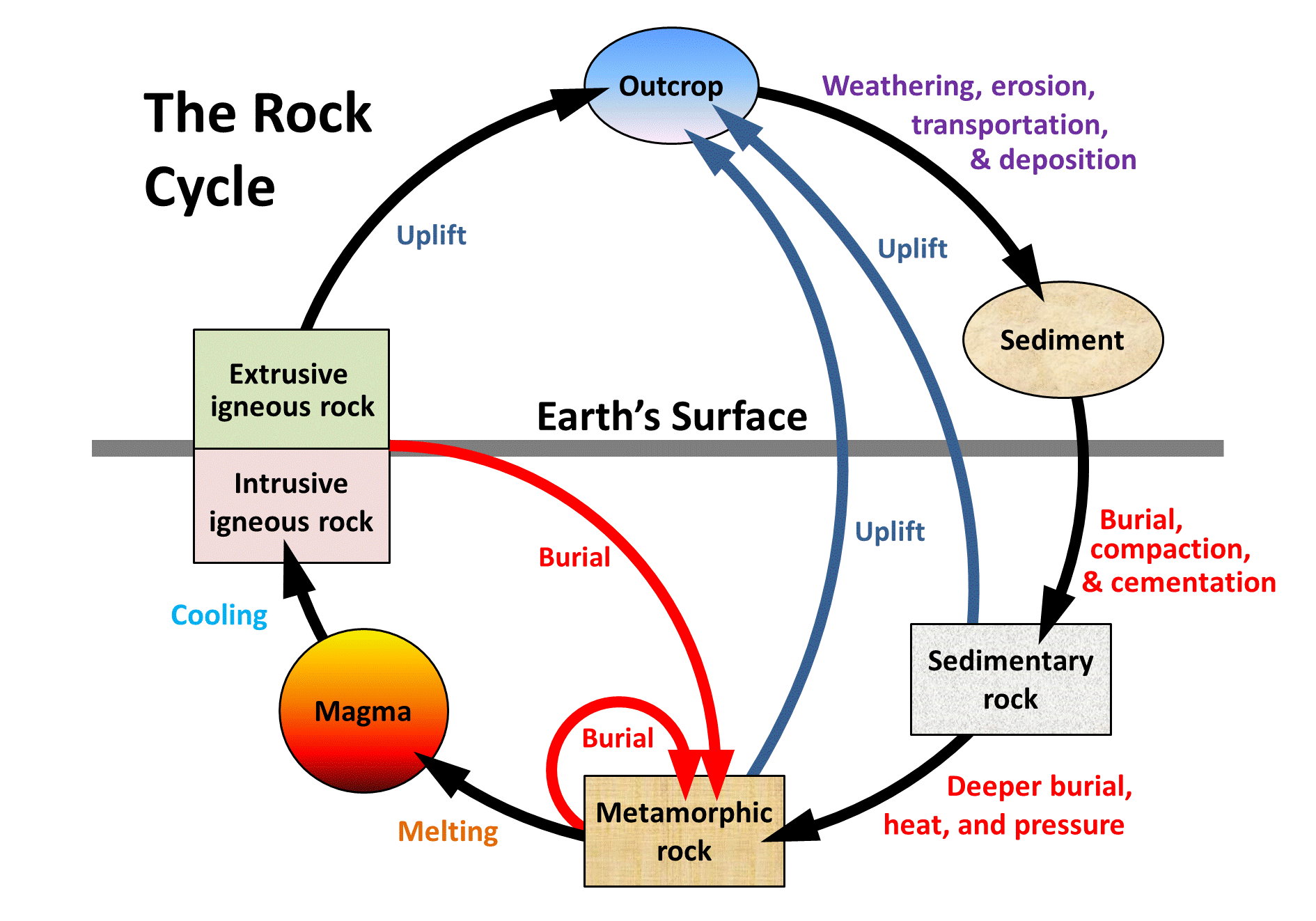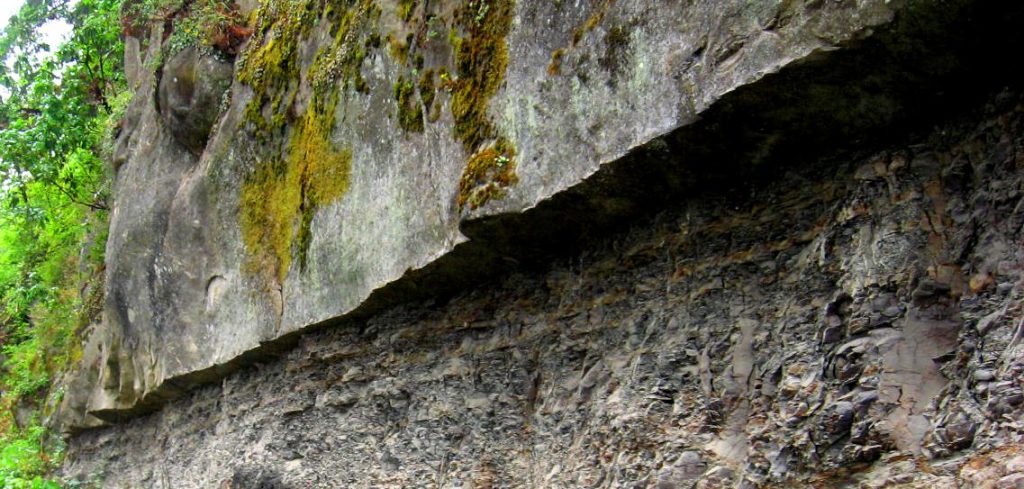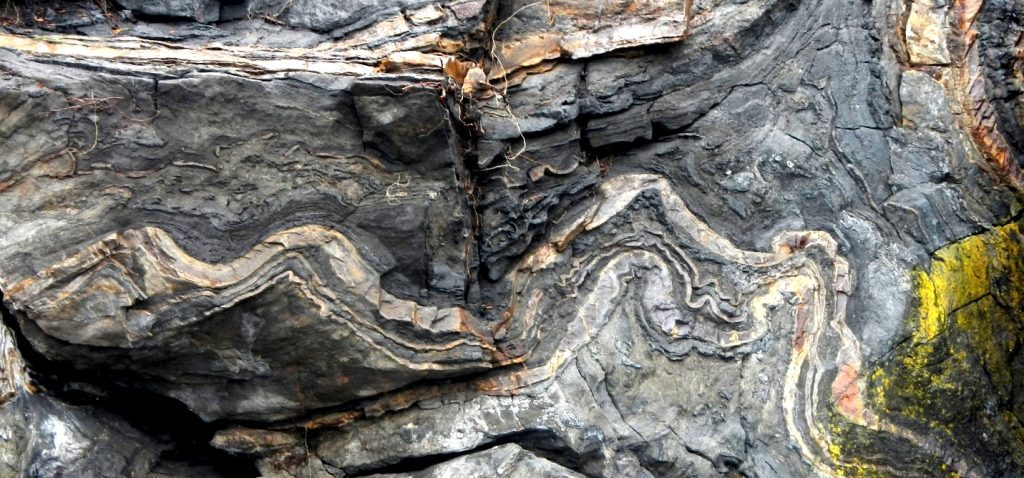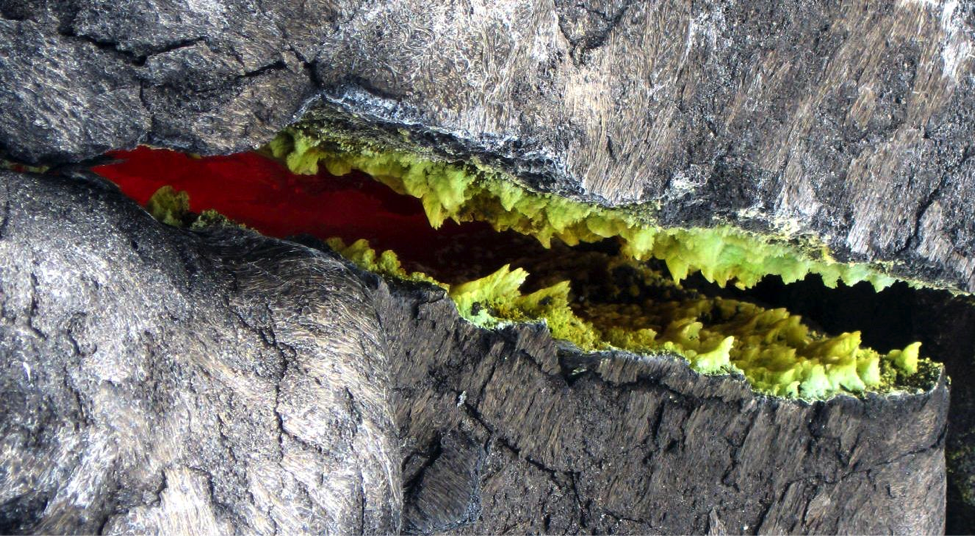Chapter 9 Metamorphism and Metamorphic Rocks
9.6 The Rock Cycle and Review of Minerals and Rocks
As noted in Chapter 7, the rock components of the crust are slowly but constantly being changed from one form to another and the processes involved are summarized in the rock cycle (Figure 9.6.1). The rock cycle is driven by two forces: (1) Earth’s internal heat engine, which moves material around in the core and the mantle and leads to slow but significant changes within the crust, and (2) the hydrological cycle, which is the movement of water, ice, and air at the surface, and is powered by the sun.
The rock cycle is still active on Earth because our core is hot enough to keep the mantle moving, our atmosphere is relatively thick, and we have liquid water. On some other planets or their satellites, such as the Moon, the rock cycle is virtually dead because the core is no longer hot enough to drive mantle convection and there is no atmosphere or liquid water.

Through the various plate-tectonics-related processes of mountain building, all types of rocks are uplifted and exposed at the surface. Once exposed, they are weathered, both physically (by mechanical breaking of the rock) and chemically (by weathering of the minerals), and the weathering products—mostly small rock and mineral fragments—are eroded, transported, and then deposited as sediments. Transportation and deposition occur through the action of glaciers, streams, waves, wind, and other agents, and sediments are deposited in rivers, lakes, deserts, and the ocean.
Exercise 9.1 Rock around the rock-cycle clock
Referring to the rock cycle (Figure 9.6.1), list the steps that are necessary to cycle some geological material starting with a sedimentary rock, which then gets converted into a metamorphic rock, and eventually a new sedimentary rock.
A conservative estimate is that each of these steps would take approximately 20 million years (some may be less, others would be more, and some could be much more). How long might it take for this entire process to be completed?
See Appendix 3 for Exercise 9.1 Answers.

Unless they are re-eroded and moved along, sediments will eventually be buried by more sediments. At depths of hundreds of metres or more, they become compressed and cemented into sedimentary rock (See Figure 9.6.2 for example). Again through various means, largely resulting from plate-tectonic forces, different kinds of rocks are either uplifted, to be re-eroded, or buried deeper within the crust where they are heated up, squeezed, and changed into metamorphic rock (Figure 9.6.3)

Mineral and Rock Review

Now that we’ve covered minerals and all three types of rocks it’s important for you to convince yourself that you’ve got them straight in your mind. As already noted, one of the most common mistakes that geology students make on assignments, tests and exams is to confuse minerals with rocks and then give a wrong answer when asked to name one or the other based on information provided.
In this exercise you are given a list of names of minerals and rocks and asked to determine which ones are minerals and which are rocks. For those that you think are minerals you should then indicate which mineral group it belongs to (e.g., oxide, sulphate, silicate, carbonate, halide etc.). For those that you think are rocks, you should describe what type of rock it is (e.g., intrusive igneous, extrusive igneous, clastic sedimentary, chemical sedimentary, foliated metamorphic and non-foliated metamorphic). The answers can be found in Rock and mineral review exercise answers in Appendix 3.
| Mineral or rock name | Rock or mineral? | If it’s a mineral, which group does it belong to? If it’s a rock, what type is it? |
|---|---|---|
| Feldspar | ||
| Calcite | ||
| Slate | ||
| Hematite | ||
| Rhyolite | ||
| Sandstone | ||
| Diorite | ||
| Olivine | ||
| Pyrite | ||
| Quartzite | ||
| Granite | ||
| Amphibole | ||
| Conglomerate | ||
| Chert | ||
| Halite | ||
| Gneiss | ||
| Mica | ||
| Pyroxene | ||
| Chlorite | ||
| Limestone | ||
| Andesite |
Media Attributions
- Native sulphur: © Steven Earle. CC BY.
Image Descriptions
Figure 9.6.1 image description: The rock cycle takes place both above and below the Earth’s surface. The rock deepest beneath the earth’s surface, and under extreme heat and pressure, is metamorphic rock. This metamorphic rock can melt and become magma. When magma cools below the earth’s surface, it becomes “intrusive igneous rock.” If magma cools above the earth’s surface, it is “extrusive igneous rock” and becomes part of the outcrop. The outcrop is subject to weathering and erosion, and can be moved and redeposited around the earth by forces such as water and wind. As the outcrop is eroded, it becomes sediment which can be buried, compacted, and cemented beneath the Earth’s surface to become sedimentary rock. As sedimentary rock gets buried deeper and comes under increased heat and pressure, it returns to its original state as metamorphic rock. Rocks in the rock cycle do not always make a complete loop. It is possible for sedimentary rock to be uplifted back above the Earth’s surface and for intrusive and extrusive igneous rock to be reburied and become metamorphic rock. [Return to Figure 3.1.1]
Images Attributions
- Figure 9.6.1, 9.6.2, 9.6.3: © Steven Earle. CC BY.
the series of processes through which rocks are transformed from one type to another
unconsolidated particles of mineral or rock
rock that has formed by the lithification of sediments
the transformation of a parent rock into a new rock as a result of heat and pressure that leads to the formation of new minerals, or recrystallization of existing minerals, without melting
